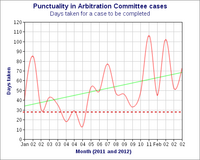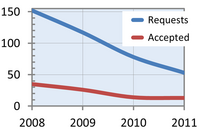User:Arcticocean/Arbitration timekeeping
Timekeeping
[edit]This is data of timekeeping in arbitration cases for 2011 and 2012. For each case closed in the years 2011 and 2012, there is listed the date opened, date closed,, time in days taken for case closure, and how farther than 28 days (per the target timetable) the case overran. The purpose of the data is to tracking the committee's punctuality in disposing of cases, which is its main function. However, several qualifications apply to raw data:
- Many cases are very complex, and their decisions cannot reasonably be drafted in a month by one, two, or even three arbitrators.
- Arbitrators are volunteers with limited time, and Wikipedia is a hobby, not a full-time job.
- Some cases do not follow the standard timetable for proceedings (which specifies cases will be closed in 28 days). In almost all such cases, the timetable will be extended to longer, not shorter, than 1 month (although a handful of cases, like the R&I review, run on a circumscribed format; and others like Noleander are closed early by motion).
| Case name | Opened | Closed | Days taken | Overrun[1] |
|---|---|---|---|---|
| Rich Farmbrough | 04/04/12 | 14/05/12 | 41 | 13 |
| Race and intelligence/Review | 16/03/12 | 14/05/12 | 58 | 30 |
| Article titles and capitalisation | 29/01/12 | 23/03/12 | 54 | 26 |
| TimidGuy ban appeal | 14/12/11 | 27/02/12 | 73 | 45 |
| Civility enforcement | 29/12/11 | 21/02/12 | 52 | 24 |
| Betacommand 3 | 03/11/11 | 15/02/12 | 102 | 74 |
| Muhammad images | 21/12/11 | 06/02/12 | 45 | 17 |
| Abortion | 12/08/11 | 28/11/11 | 106 | 78 |
| Senkaku Islands | 17/08/11 | 05/10/11 | 48 | 20 |
| Manipulation of BLPs | 02/08/11 | 05/09/11 | 33 | 5 |
| Cirt and Jayen466 | 24/07/11 | 10/09/11 | 46 | 18 |
| MickMacNee | 17/06/11 | 04/08/11 | 47 | 19 |
| Tree shaping | 28/04/11 | 15/07/11 | 77 | 49 |
| Arbitration Enforcement sanction handling | 12/03/11 | 05/05/11 | 53 | 25 |
| Racepacket | 30/04/11 | 19/06/11 | 49 | 21 |
| Henri Coanda | 22/03/11 | 05/04/11 | 13 | 15 |
| Rodhullandemu | 07/03/11 | 06/04/11 | 29 | 1 |
| Noleander | 30/03/11 | 18/04/11 | 18 | -10 |
| Kehrli 2 | 11/02/11 | 16/03/11 | 35 | 7 |
| Monty Hall problem | 12/02/11 | 25/03/11 | 43 | 15 |
| Shakespeare authorship question | 16/01/11 | 16/02/11 | 30 | 2 |
| Longevity | 22/11/10 | 17/02/11 | 85 | 57 |
| World War II | 30/11/10 | 10/01/11 | 40 | 12 |
| Average | (DD/MM/YY) | 51 | 23 | |
- ^ Colours:
Cases which closed on or earlier than 14 days after the target date for closure are highlighted in Green.
Cases which closed between 14 and 28 days (2-4 weeks) after the target date are highlighted in Orange.
Cases which closed after 4 weeks of the target date will be highlighted in Red.


- Compilation
I pull the dates of these cases by hand, from the index of closed cases and from the "Date opened" line at the top of each case. I calculate the difference between the dates, and the averages, using a spreadsheet I keep locally.
Community post-mortems
[edit]The following are statistics on how much community discussion there was of recently-closed cases. Case post-mortems are generally made at Wikipedia talk:Arbitration Committee/Noticeboard. Larger discussions may mean that the case decision was controversial in the view of the thread's participants, that some provision in the final decision was ambiguous or incorrect, or that there was some error in closing or implementing the decision. Post-mortems are useful indicators of community opinion, and larger discussions have a tenuous but established link with how the decision is received, but raw statistics on the post-mortem thread are nevertheless of limited use without a more in-depth analysis.
| Case name | Word count |
|---|---|
| Rich Farmbrough | 00000 |
| Race and intelligence/Review | 00162 |
| Article titles and capitalisation | 00239 |
| TimidGuy ban appeal | 02688 |
| Civility enforcement | 08233 |
| Betacommand 3 | 22592 |
| Muhammad images | 00601 |
| Abortion | 00393 |
| Senkaku Islands | 00000 |
| Manipulation of BLPs | 00000 |
| Cirt and Jayen466 | 01749 |
| MickMacNee | 02322 |
| Tree shaping | 00102 |
| Arbitration Enforcement sanction handling | 09507 |
| Racepacket | 00030 |
| Henri Coanda | 00000 |
| Rodhullandemu | 33644 |
| Noleander | 00519 |
| Kehrli 2 | 00000 |
| Monty Hall problem | 00244 |
| Shakespeare authorship question | 00000 |
| Longevity | 00204 |
| World War II | 00000 |
| Average | 03618 |
